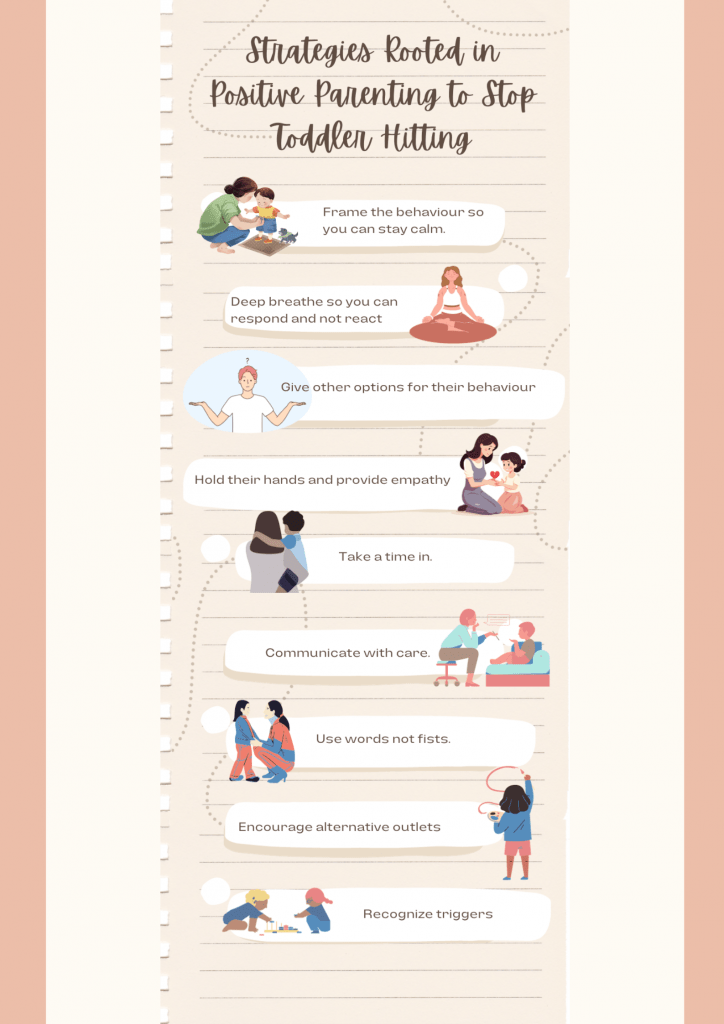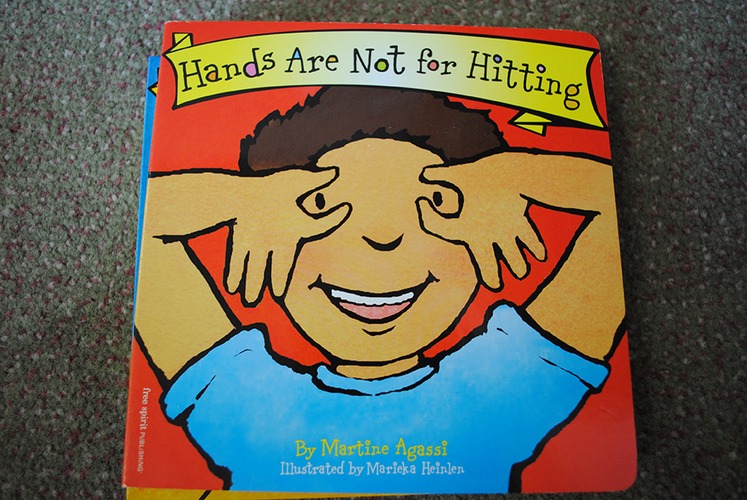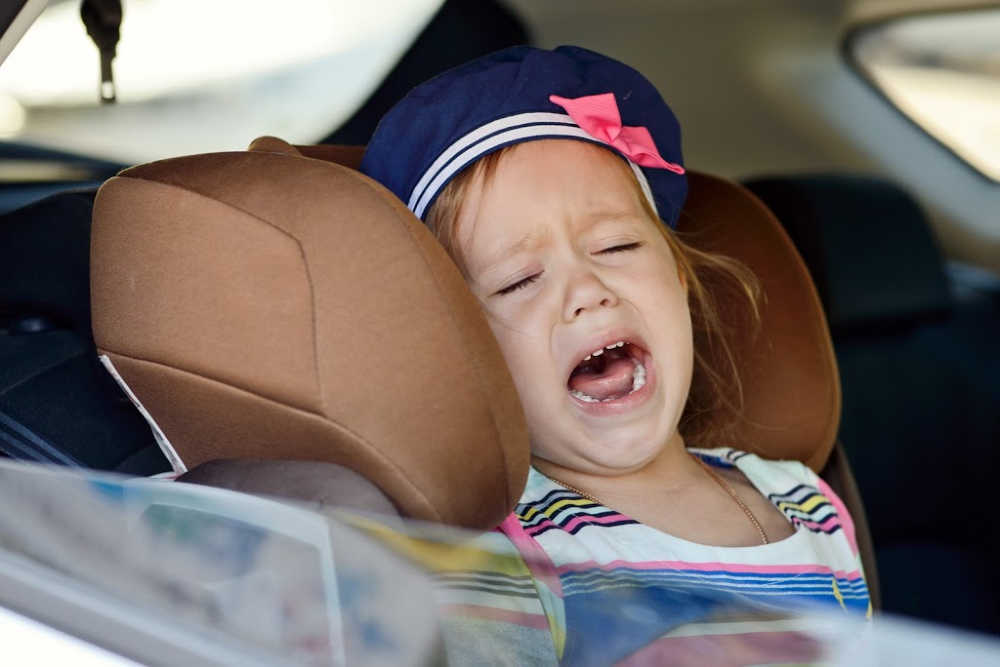When your toddler hits for the first time, it is shocking. Fortunately, there are effective strategies to stop toddler hitting without using punishment.
Yesterday, in my parenting group, a parent shared her story:
I have the sweetest, kindest two-year-old. He is attentive and fun-loving. Lately, out of the blue, my toddler started hitting his baby brother. We don’t spank. He hasn’t had any aggression that I can think of modelled to him. And still he hits again and again. Please help.
I remember the first time my toddler son hit me. We were playing with his fisher price car garage on a relatively quiet and dreary afternoon. The house was silent except for our play.
“Can you grab the orange car… Good boy!”
We took turns to see which would go faster: the heavier orange car or the lighter blue car. We were laughing when my daughter came to ask for help with opening the teal-coloured play dough.
Then suddenly,
Whack!
I was taken aback. Not only had just been hit by my child for the first time, my son also has big strong hands. It hurt!
I sat there mystified. “Oh, we don’t hit Mama. Only gentle touches.”
We went back to playing. Another minute or so went by and,
Whack. again.
This time I hadn’t been distracted… I was with him playing the game he wanted to play.
If your toddler hits, rest assured there are many strategies to use to teach him to stop hitting.

Understanding Toddler Development
Toddlers undergo a remarkable journey of growth that encompasses various domains – physical, emotional, cognitive, language, and social development. Knowing what your child goes through can effectively help you dive deep into why they hit in the first place.
Toddlers are like sponges, soaking up experiences and knowledge at an astonishing rate. Between 12 and 18 months, they strive to be independent. At this stage, they’re mastering new physical skills, such as walking and running, opening up possibilities. As their curiosity blooms, they’re eager to explore everything within reach.
As your little ones approach their second year, their language skills start to take shape. They begin uttering words and phrases, albeit often incomprehensible to others. It’s a delightful phase as they learn to communicate their needs, sometimes with incredible frustration.
So, Why Does My Toddler Hit?
Hitting behavior in toddlers can be perplexing. However, it often stems from their limited coping skills and struggle to express themselves effectively. They are just beginning to comprehend the world and grapple with a flood of emotions. Yet, their ability to communicate their feelings and desires through language is still developing. This communication gap can lead to frustration and even anger.
Furthermore, their emerging social skills are a work in progress. They’re learning how to interact with others, share toys, and understand the concept of personal space. Hitting, or sometimes biting, might sometimes emerge as a way to protect their territory or assert their needs when they feel threatened or misunderstood.
In essence, hitting behavior in toddlers often manifests their internal turmoil. Their cognitive and emotional worlds are expanding, but their coping and language skills are still catching up.
What Can We Do?
As parents, recognizing this developmental context is crucial when identifying how to stop your toddler from hitting. It’s an opportunity to teach alternative ways of expressing their needs and feelings. It also allows us to support their overall growth in language, coping skills, and social understanding.
Here are 5 Strategies Rooted in Positive Parenting to Stop Toddler Hitting
1. Frame the behaviour so you can stay calm. Toddlers can hit for a number of reasons.
Some examples include:
- Curiosity – they want to see what will happen when they hurt you.
- Difficulty communicating – they lack the language to express what they feel, want, or need.
- The desire for rough and tumble play – children enjoy roughhousing because it allows them to test out their strength and power. In the context of rough and tumble play, children learn how to take turns, control their behaviour to not hurt one another, and not overreact.
- Fear – Humans respond to stress using their fight or flight response. Even if a child’s fear seems innocuous to us, it could feel rather dangerous to her.
Related reading: Why Boys (and Girls) Need Rough and Tumble Play
2. Deep breathe so you can respond and not react. Then,
Use positive language to help your child understand what he can do instead:
- “Gentle touches.”
- “Hands to self.”
- “Use your words.”
- “Say ‘help’.”
3. Give other options for their behaviour.
For example:
- Put your hand over hers and show her gentle touches.
- Offer a stuffed animal to hit.
- Suggest a pillow fight.
- Build and knock over blocks.
4. Hold their hands and provide empathy.
If your child is about to hit, hold his hands and tell your child he cannot hit. He will likely cry out of frustration. It is important to stay calm and hold space for the big feelings. Affirm his feelings, “I know you’re upset. I’m here for you.”
5. Take a time in.
Take your child away from a play date or the playground. Sit with her and provide her comfort until she is calm and ready to return. Avoid lecturing and do not chastise. Simply hold your child or sit beside her until she is prepared to play.
Related reading: Time Ins and the Fundamental Mistake You Want to Avoid
Keep Toddler Hitting at Bay: Strategies and Tips for Parents

Toddlers may occasionally resort to hitting as a way to express their frustrations or unmet needs. As parents, it’s vital to address this behavior as calmly as possible. Resorting to anger and punishment is counterproductive and can hurt both of you in the long run.
Let’s explore effective strategies to help you guide your toddler away from hitting and towards healthier ways of expressing themselves.
Communicate with Care
As parents, it’s our job to create an environment where children feel safe saying what they need and want. Listen actively, validate their feelings, and offer reassurance. Remember, toddlers are still developing their language skills, and clear communication can help reduce their frustration.
- Use simple language: Speak in short, clear sentences.
- Non-verbal cues: Pay attention to your body language and facial expressions, as toddlers often rely on these cues to understand your emotions.
- Offer choices: Providing choices empowers toddlers and can reduce frustration.
- Be patient: Allow your child time to finish what they’re saying even if it takes a little longer.
Use Words, Not Fists
Children learn by observing how we react and act in certain situations. If they witness us using non-violent conflict resolution methods, they are more likely to follow suit.
- Talk it out: When disagreeing with someone, “use your words” to settle an issue.
- Use calming techniques like deep breaths or counting.
- Show empathy: Let them know you understand what they’re going through.
Encourage Alternative Outlets
Toddlers need safe and constructive outlets for their pent-up energy and emotions.
- Art and crafts: Let them explore their creativity with drawing, painting, or crafts.
- Physical play: Provide opportunities for safe physical activities like dancing, jumping, or even gentle wrestling.
- Relaxation techniques: Teach them relaxation methods, such as deep breathing or progressive muscle relaxation.
Recognizing Your Child’s Hitting Triggers
Identifying the triggers for your toddler’s hitting is vital in helping them manage their impulses. Triggers can vary from one child to the other. However, some common ones include frustration, fatigue, hunger, or feeling overwhelmed.
Anticipate triggers
Pay attention to situations that lead to hitting, such as sharing conflicts or transitions. When you hear, “This is mine!” loudly during a playdate, intervene before it escalates into something physical.
Offer Choices
Once you’ve identified a trigger, guide your child toward non-violent ways of dealing with their emotions or needs. You may ask, “Would you want to play with your doll or try out the swing?”
Provide comfort
When your child is upset, offer comfort and reassurance to help them calm down. Don’t match their frustrations with your own. Try to understand where their feelings are coming from and address the issue from a place of love.
When Siblings Hits One Another
Do you find your children hitting each other and struggling to get along? You’re not alone. It’s a common scenario in many households. It can be frustrating to see your kids fighting over Mario Kart or an old sticker (yes, they’d squabble over anything). The good news is that you can manage these misunderstandings without raising your voice.
Strategies to Stop the Sibling Hitting War

First and foremost, it’s crucial to maintain consistent boundaries. Like all of us, children feel secure when they understand the rules. Make sure they know that hitting is not acceptable and that there are consequences for doing so. Be firm but gentle.
Next would be to teach your kids to use their words. Children can better understand each other when they learn to express their feelings. It also teaches them valuable conflict-resolution skills they’ll carry way into their adult lives.
Additionally, always remember that children often learn by example. If they see you reacting to negative behavior with hitting or yelling, they are more likely to do the same.
Creating Healthy Sibling Relationships
Help your children understand that they are a team within the family. This approach teaches them that they are there to support each other rather than compete against one another. Reinforce the idea that treating each other kindly and with respect can make them feel good and warm inside. In turn, a positive feeling is generally going around in the house.
Lastly, remind them that it’s okay to ask for help from someone else when they’re having a hard time getting along. This might be you, another family member, or a trusted friend. Sometimes, a third-party perspective can provide a fresh solution to a recurring problem.
Sibling harmony is an ongoing process. Children grow and change, and their relationships evolve with them. It’s perfectly normal for them to have ups and downs. With your guidance and these strategies, you can help them build lasting, healthy relationships based on mutual respect and a genuine love for one another.
My Toddler’s Hitting Becomes More Frequent. Should I Be Concerned?
When it comes to toddler hitting, it’s not uncommon for little ones to exhibit aggressive behavior as they navigate the complexities of growing up. Yet, there are times when negative behavior becomes more concerning, raising the need to seek professional guidance.
So when must we consult a clinical child psychologist or counselor? When is the right time to address severe hitting behaviors in our kids while keeping their well-being in check?
When to Seek Professional Help

While it’s important to remember that mild aggressive behavior can be part of normal development, parents should consider these factors to determine if it’s time for a doctor’s visit.
-
The frequency and intensity of the hitting episodes
Consistent hitting can be a red flag, particularly if it leads to them hurting someone physically or causing emotional distress.
-
The context of the hitting
Is it happening only in specific situations or with certain people? If the hitting extends beyond mere occasional outbursts and occurs in various settings, it may be time to consult an expert.
-
Age-appropriateness of the behavior
It’s not unusual for toddlers to experiment with hitting to express frustration or assert independence. However, severe hitting that continues past kindergarten, for example, may indicate a deeper issue.
Other Signs To Watch Out For
Recognizing the signs early on is crucial to address the negative behavior in the best way possible. If you notice the following in your little one, seek professional help immediately.
- The child’s aggression disrupts their daily life
- It interferes with their relationships or hinders their social and emotional development.
- Their hitting comes with withdrawal, anxiety, or difficulty in regulating emotions.
In some cases, hitting can indicate underlying issues -sensory processing disorders, emotional trauma, or developmental delays. A doctor can pinpoint the root causes and tailor healthier coping mechanisms.
Additional resources for difficult toddler behaviour and to stop toddler hitting
Read: 10+ Tips to Mitigate Difficult Toddler Behaviour
Read: How to Gently Handle Aggression in Young Children
Purchase and read to your child: Hands Are Not For Hitting


Read: 8 Ways To Calm Kids Down Anywhere
Read: When Your Toddler Hits You: A New Perspective
Purchase and read: Peaceful Parent Happy Siblings
Read: Why You Shouldn’t Punish Tantrums and What to Do Instead
My son didn’t stop hitting overnight. There were still times where we would play and he would hit. In a short time, the hitting became less frequent and he started using his words more.
For more insights like these, join my positive parenting group on Facebook here.
More Related Readings

10+ Tips to Mitigate Difficult Toddler Behaviour
Front-Loading, Redirection & Connection: 3 Powerful Strategies for Parenting a Strong-Willed Child
Why you shouldn’t punish tantrums and what to do instead
How to handle your toddler’s potty training regression
Science says this is the best way to discipline a child
Find more of our favorite resources Here












10 comments